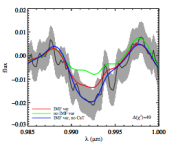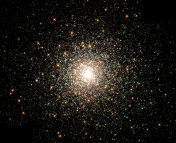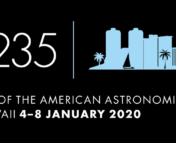In this series of posts, we sit down with a few of the keynote speakers of the 235th AAS meeting to learn more about them and their research. You can see a full schedule of their talks here, and read our other interviews here!
Dr. Andrea Dupree can’t get enough of spectra. A senior astrophysicist at the Harvard-Smithsonian Center for Astrophysics (CfA), Dupree has made significant contributions to stellar astrophysics using the technique of spectroscopy. “I’ve been a spectroscopist from the beginning,” she says, listing off the many wavelengths she has worked in. “You can find out amazing things from looking at these spectra.”
Stellar Stories Through Spectra
Dupree will share some of these insights applied to stellar accretion as a keynote speaker at AAS 235. Young stars accrete material, which then affects the stellar atmosphere. The stars later shed this material in the form of winds and jets—and we can watch this all occur by analyzing spectra. This story has ramifications beyond stars themselves. “This is all tied into the cycle of material in the galaxy and in the universe,” Dupree explains. The interaction between the stars and the interstellar medium is central to the narrative of galaxy formation, and the material ejected from stars ends up comprising a significant portion of the atoms, ions, and dust in the galaxy.
In 2013, Dupree got a close-up look at this process with the young star TW Hydrae. A nearby accreting star, TW Hydrae has an accretion disk oriented face-on to us. Using the Chandra satellite and Magellan telescope, Dupree and her collaborators took high-resolution X-ray and optical spectra and constructed a play-by-play: infalling material hit the stellar atmosphere, causing a shockwave through the layers of the star, which heated up the corona and caused a stellar wind. “This is amazing because … we can actually see the accretion process live and in action,” she says.
While spectroscopy is critical for revealing the plot details, sometimes a photograph is the necessary hook. Back in 1995 (at AAS 187!) Dupree and her collaborators announced the first ever direct image of a star, Betelgeuse in the Orion constellation. This revealed an unexpected hot spot on its surface, allowing for an unprecedented study of stellar convection—but Betelgeuse wasn’t done surprising us. “In November we got notice from people who were looking at the brightness [of Betelgeuse] and they were saying, ‘Uh oh, it seems to be getting fainter!’” Dupree says. In the past few weeks, the star has gotten fainter than it has been in the last 50 years, and a Christmas Eve measurement showed that it is still getting dimmer, as seen in the figure below. Many astronomers are excited that the dimming could be an indication that Betelgeuse is gearing up to go supernova, an event that would be as bright as the full moon in the sky. However, another explanation is that this is a natural minimum in the star’s periodic variation. Only time will tell, and Dupree is keeping a close eye on this mysterious star.

Seeing Double in Globular Clusters
Another open question that Dupree is using spectra to probe is the stellar populations of globular clusters (GCs). GCs were thought to contain stars that co-evolved together, of the same age and chemically homogenous. But about 10 years ago, observations of GCs in the Milky Way from the Hubble Space Telescope allowed astronomers to make much more precise color-magnitude diagrams, which allow us to characterize their stars. This revealed not one main sequence, but two, indicating two separate populations of stars with different chemical makeups. “Many if not all globular clusters have multiple populations!” Dupree says. “Now how did this happen? We do not know! I mean, we really don’t know.”
Dupree and others have been trying to tease out the stories of these populations by using spectroscopy. They took spectra of younger GCs in the nearby Magellanic Clouds, and found something they couldn’t see from just images: the redder stars are rotating so rapidly that they form “decretion disks,” with material flying off around the equator, while other stars are more slowly rotating. One hypothesis to explain how this results in multiple populations is that the ejecta from these disks form a second generation of stars; another idea is that all stars were formed rapidly rotating, and some are spinning down. While all scenarios are still unproven, Dupree is excited about all that we’ve been able to learn from these observations. “That’s why I’ve fallen in love with spectra, because they can give you many definitive answers to what’s happening in the universe,” she says.
Serious about Astrophysics
Dupree first encountered astronomy as an undergraduate at Wellesley College, a women’s college in Massachusetts. “I discovered that it was also mathematics and physics but it was real,” she says. “You could go out and grab a piece of the sun. You could measure the light from the stars.” She received a Woodrow Wilson fellowship for graduate study, which she took to UC Berkeley and then transferred to Harvard. After receiving her PhD from Harvard in 1968, she stayed on as a researcher at Harvard-CfA, and in 1979 got an appointment at the Smithsonian Astrophysical Observatory, where she has worked since.
The path hasn’t always been smooth, however, particularly for a woman in the field. When Dupree was considering graduate schools, she sent an inquiry to Princeton. Their response: “Well, we don’t have a school of animal husbandry, and we don’t accept women,” Dupree remembers. When she interviewed for the Woodrow Wilson fellowship, she also ran into sexism. The interviewers asked how they “knew she was serious” and not just going to run off and get married. “Can you believe!” Dupree says. “I was so flabbergasted, having gone to a women’s college where I had women professors and everyone was going to do something.”
The issues didn’t disappear when she became an established researcher. At one point, she found out that a male colleague had a 30% higher salary than her. After confirming that her research output and achievements matched his, she approached her supervisor. He responded that she has a husband who’s a professor, so she doesn’t have to worry about that, while the male researcher is supporting a family. Appalled, Dupree made her case to higher-ups, and successfully argued for a raise. While she says that “it hasn’t been easy and it’s still not easy,” she does see positive change in the field today.
Astronomy’s Past and Future
Dupree is no stranger to the AAS: she served as President of AAS from 1996-1998. She recalls it as a productive though sad time, as both Carl Sagan and Lyman Spitzer passed during her term. While president, she organized for increases to the U.S. science budget, partnering with other scientific professional organizations. The society then was much smaller, with a meeting drawing around 500 people; this year’s winter meeting is expected to bring over 3000 participants (!).
Dupree is excited to see what the next generation of astrophysicists do. When asked to give advice to astronomy students, Dupree emphasizes choosing to research what you enjoy. “Do what you like, do what excites you. You’re going to have to live with this and chase it down and study it and analyze it for a while.” She also advises students in astronomy to “define your expertise,” in order to make clear your contributions and get recognition. At the same time, Dupree values the range of topics she has gotten to study, and encourages students to explore other areas if they have the flexibility. “Don’t hesitate to go to colloquia that you might not understand and try to broaden your horizons,” she says, “because a lot of exciting things and fundamental things come from the edges and the interdisciplinary work in science.”
Hear Andrea Dupree talk about accreting stars at her AAS plenary talk “Diet of the Stars: Mass Accretion and Mass Loss” at 8:10 AM on Wednesday, January 8 at #AAS235.



